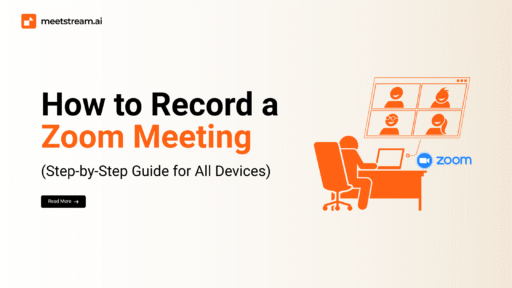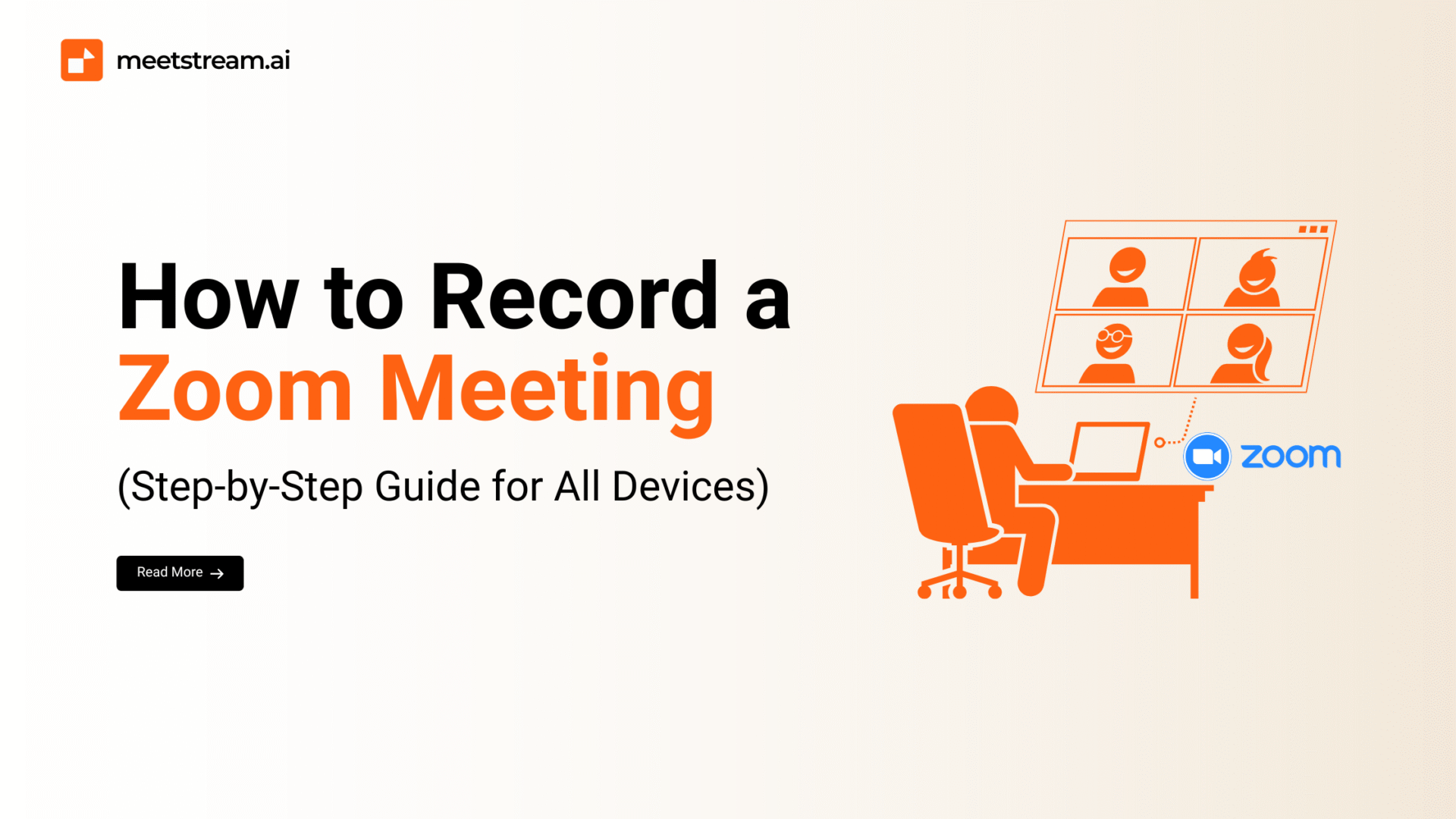In 2025, recording Zoom meetings has evolved into a vital capability for virtual collaboration, corporate training, distance education, and hybrid business models.
Whether you’re organizing an international webinar, documenting a stakeholder call, or archiving internal project updates, recording your Zoom sessions ensures knowledge retention, content repurposing, and regulatory compliance across diverse industries.
It also explores recording methods (local vs. cloud), user permissions, error fixes, transcription options, workflow automation, and secure sharing strategies.
This in-depth guide explains how to record Zoom meetings across desktop (Windows/macOS), mobile (iOS/Android), and third-party tools.
Zoom Recording Options: Local vs Cloud (2025 Overview)
Zoom provides two primary options to record meetings—Local Recording and Cloud Recording—each tailored for different storage preferences, accessibility needs, and subscription levels.
1. What is Local Recording?
Local recording captures both video and audio and saves it directly to your device’s internal storage, external SSD, or cloud-synced folders like Google Drive or Dropbox if integrated. Available on all Zoom plans, it’s best suited for users with sufficient local storage and no need for cloud syncing.
- Supported Formats: .MP4 for video, .M4A for audio
- Access Control: Only accessible on the host’s device
- Use Cases: Training materials, project documentation, offline backup
2. What is Cloud Recording?
Cloud recording uploads your Zoom session directly to your Zoom account’s cloud dashboard. It’s available to users on Pro, Business, Enterprise, and Education plans.
- Features: Multi-view recording (gallery, speaker), transcription, searchable archives
- Accessibility: Files accessible across devices via browser
- Storage Limits: Dependent on Zoom subscription; scalable with add-ons
Feature Comparison Table
| Feature | Local Recording | Cloud Recording |
| Plan Requirement | Free & Paid | Paid Plans Only |
| File Location | On-device (hard drive, SSD) | Zoom Cloud Dashboard |
| Playback Access | Host device only | Cross-device (Web, Mobile, App) |
| Includes Transcripts | No (manual upload required) | Yes (AI-generated on Pro+ plans) |
| Security & Sharing | Manual file handling | Password protection, domain restriction |
| Ideal For | Solo professionals, educators | Teams, agencies, HR, legal, remote ops |
User Roles and Permissions for Recording
In Zoom’s role-based access system, only the meeting host has default permission to initiate a recording.
If you’re a co-host, or if you’ve been granted temporary rights by the host, you’ll see the record button on your interface.
1. Host-Controlled Permissions
- Assign Recording Privileges: During a live meeting or while scheduling
- Participant Limitations: Cannot record unless granted access
- Admin Console Settings: Account owners can enforce or restrict recording across all users
How to Record a Zoom Meeting on Desktop (Windows & macOS)
1. Local Recording on Desktop
System Requirements:
- Zoom desktop client (latest version)
- Host or co-host role
- Minimum free disk space (recommended: 2GB+)
Step-by-Step Instructions:
- Open the Zoom desktop app and launch or join a meeting.
- Click the Record button in the bottom toolbar.
- A “Recording…” label will appear on the screen.
- When finished, click Stop Recording or end the meeting.
- Zoom will convert the temporary file into a playable video once the meeting ends.
Default File Path:
Documents > Zoom > [Meeting Name and Timestamp]
Customize storage path by navigating to Settings > Recording > Store My Recordings At.
2. Cloud Recording on Desktop
Enabling Cloud Recording:
- Sign into Zoom.us
- Navigate to Settings > Recording
- Toggle on Cloud Recording under “Recording Settings”
Recording a Meeting:
- Host a meeting
- Click Record > Record to the Cloud
- A processing status will appear after ending the meeting
Accessing Your Files:
- Go to My Account > Recordings
- Download, stream, delete, or share from this portal
Bonus Tip: Use folder-based organization, tags, and naming conventions for large libraries of recordings, especially for content marketing, compliance audits, or team onboarding.
Troubleshooting Common Zoom Recording Issues
1. Record Button Not Visible
Likely Causes:
- Not the host
- Permissions not granted
- Admin-level restrictions
Fix:
- Request host permission or assign co-host privileges manually.
2. No Audio in Recordings
Checklist:
- Verify microphone selection under Audio Settings
- Ensure no mute status or hardware-level disconnection
- Test audio in advance with Zoom’s “Test Mic” feature
3. Corrupted or Missing Files
Preventive Measures:
- Avoid shutting down during conversion
- Ensure sufficient disk space and system memory
- Save backups using automated sync tools like Dropbox or OneDrive
Advanced Tools to Enhance Zoom Recording Workflows
Intelligent assistants like MeetStream API, Sembly, and Otter Assistant:
- Auto-join Zoom calls
- Record and transcribe in real time
- Identify speakers and generate smart highlights
- Send meeting summaries to Slack, Notion, or email
Ideal for: Sales teams, support reps, HR departments, and training managers
How to Automatically Record Zoom Meetings
1. Set Up Auto-Recording for Scheduled Meetings
Steps:
- Sign in to Zoom
- Go to Settings > Meeting > Schedule Meeting
- Enable Automatically Record Meeting
- Select Cloud or Local recording based on storage preference
2. Automate Workflows with Integrations
Tools like Zapier, Make, and n8n allow workflow automation such as:
- Auto-uploading Zoom recordings to Google Drive, OneDrive, or Dropbox
- Sending Slack messages post-meeting
- Logging meeting summaries in CRMs like HubSpot or Salesforce
These integrations streamline content organization and improve operational efficiency across remote teams.
How to Transcribe, Edit, and Share Zoom Recordings
1. Transcription Options
Zoom’s Native Transcription (Pro+ plans):
- Enable in Recording Settings
- Generates searchable, time-synced transcripts
Third-Party Tools:
- Otter.ai: Speaker labels, collaboration, AI summaries
- Descript: Edit video by editing transcript text
- Grubby AI: Real-time speech recognition with keyword tagging
2. Exporting & Sharing
- Export transcripts in .txt, .vtt, or .srt formats
- Embed video + transcript in company LMS, blogs, or knowledge bases
- Use Zoom’s sharing options:
- Password-protected URLs
- Expiration dates
- Domain-restricted access
- Password-protected URLs
Final Thoughts
In 2025, Zoom recording is no longer a technical add-on—it’s a business necessity.
Whether you’re archiving project calls, delivering training, or building a content library, Zoom’s local and cloud recording capabilities, paired with AI-powered transcription, ensure streamlined communication and maximum knowledge retention.
Enhance your workflow further with tools like MeetStream API, Otter, and Zapier. Always follow best practices: obtain consent, store files securely, and automate where possible.
Zoom Recording FAQs
Can you record a Zoom meeting without host permission?
No, unless you use external screen recorders—subject to local laws and company rules.
Why is my recording button missing?
You’re either not the host or recording permissions are restricted.
How long does Zoom store cloud recordings?
30 days (Basic Pro), 90–180 days (Business), or unlimited with added storage licenses.
Are attendees notified when a recording starts?
Yes. Zoom displays a persistent recording indicator and plays a voice prompt.
Can I edit Zoom recordings?
Yes. Use Descript, Camtasia, or iMovie for post-production editing and enhancements.





